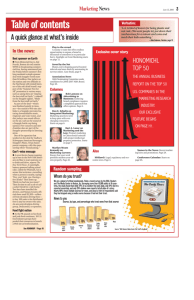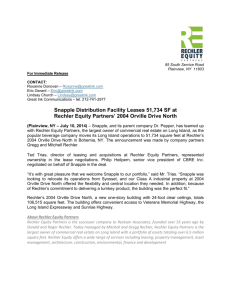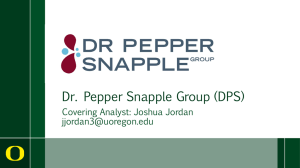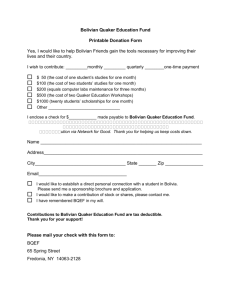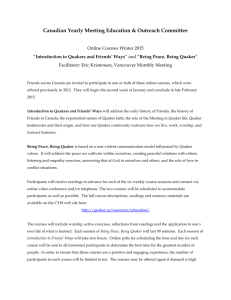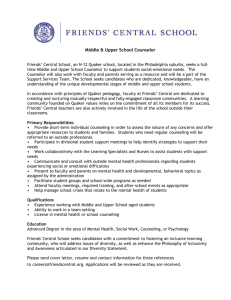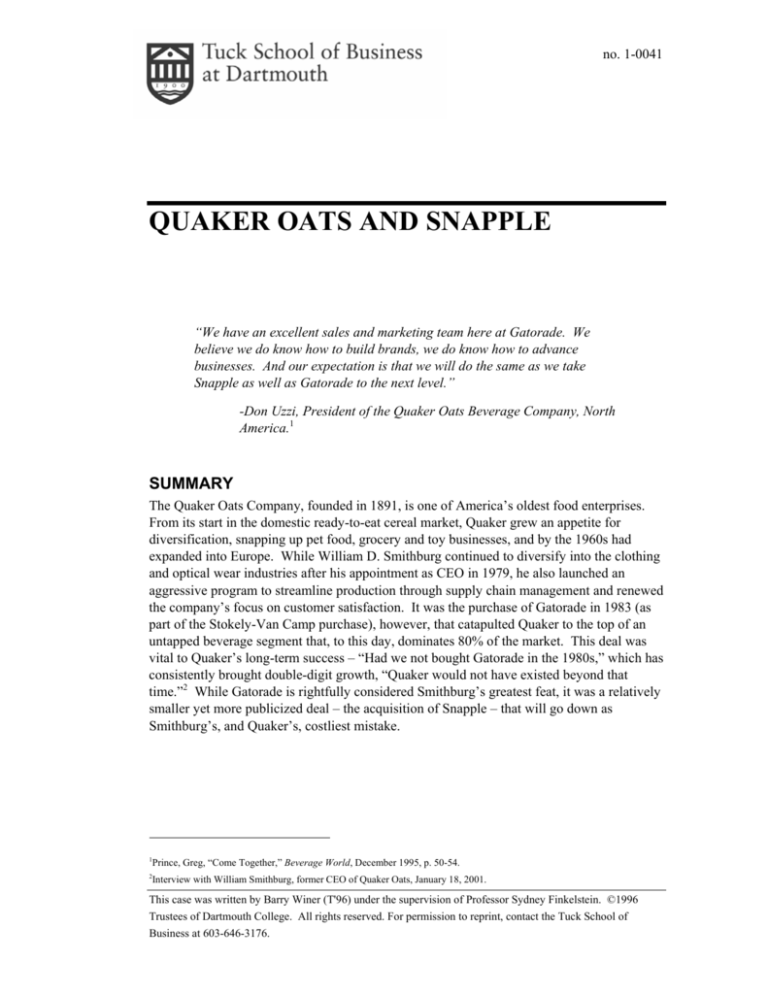
no. 1-0041
QUAKER OATS AND SNAPPLE
“We have an excellent sales and marketing team here at Gatorade. We
believe we do know how to build brands, we do know how to advance
businesses. And our expectation is that we will do the same as we take
Snapple as well as Gatorade to the next level.”
-Don Uzzi, President of the Quaker Oats Beverage Company, North
America.1
SUMMARY
The Quaker Oats Company, founded in 1891, is one of America’s oldest food enterprises.
From its start in the domestic ready-to-eat cereal market, Quaker grew an appetite for
diversification, snapping up pet food, grocery and toy businesses, and by the 1960s had
expanded into Europe. While William D. Smithburg continued to diversify into the clothing
and optical wear industries after his appointment as CEO in 1979, he also launched an
aggressive program to streamline production through supply chain management and renewed
the company’s focus on customer satisfaction. It was the purchase of Gatorade in 1983 (as
part of the Stokely-Van Camp purchase), however, that catapulted Quaker to the top of an
untapped beverage segment that, to this day, dominates 80% of the market. This deal was
vital to Quaker’s long-term success – “Had we not bought Gatorade in the 1980s,” which has
consistently brought double-digit growth, “Quaker would not have existed beyond that
time.”2 While Gatorade is rightfully considered Smithburg’s greatest feat, it was a relatively
smaller yet more publicized deal – the acquisition of Snapple – that will go down as
Smithburg’s, and Quaker’s, costliest mistake.
1
Prince, Greg, “Come Together,” Beverage World, December 1995, p. 50-54.
2
Interview with William Smithburg, former CEO of Quaker Oats, January 18, 2001.
This case was written by Barry Winer (T'96) under the supervision of Professor Sydney Finkelstein. ©1996
Trustees of Dartmouth College. All rights reserved. For permission to reprint, contact the Tuck School of
Business at 603-646-3176.
Quaker Oats and Snapple
no. 1-0041
The Rise of the Snapple Beverage Corporation
“We made the first ready-to-drink tea that didn’t taste like battery acid.” – Arnold
Greenberg, co-founder of the Snapple Beverage Corporation.3
Snapple, formerly known as Unadulterated Food Products, Inc. when it began in 1972, was created by
two window washing brothers-in-law, Leonard Marsh and Hyman Golden, and a health food store
owner, Arnold Greenberg. The New York City natives began distributing fruit juices, all natural
sodas and seltzers, and fruit drinks to local health stores by 1986, emphasizing a wholesome image
through its slogan, “Made from the best stuff on earth.” It then entered the developing iced tea market
the next year with a brewed, high quality, “new age” Ready-to-Drink (RTD) tea, which would prove
to be a pivotal early move.
The Thomas H. Lee Company of Boston took interest in the growing company and successfully
proposed a leveraged buy-out in 1992, renaming it “Snapple” and taking it public a year later.
Wanting to propel the brand to national distribution, Snapple rolled out an advertising campaign
centered on a “customer relations, regular people” theme. An employee, Wendy Kaufman, became
the “face” of Snapple on TV, and her friendly “Greetings from Snapple!” salute and penchant for
answering fan mail on the air helped build the company’s “quirky” positioning. Snapple also enlisted
the support of offbeat personalities, including top-rated shock-jock Howard Stern and talk show host
Rush Limbaugh, to create a quirky, individualist image that wooed a cult-like following. Another
mainstay to Snapple’s success was in an aggressive distribution and employee loyalty strategy,
bolstered by a health and fitness craze prevalent at the time. Snapple had an extensive and dependable
network of independent co-packers and distributors to prepare, bottle, warehouse, and sell its
products. Not only did these distributors generate high margins carrying Snapple, they also had the
option of delivering other beverages to chain stores, further boosting profitability. Snapple also
prided itself on its people-focused management style – no layoffs and employee recognition have
always been the rule. Approaching its distribution and employee relationships with a relaxed,
respectful attitude, Snapple earned tremendous internal and operational loyalty.
Snapple also captured a significant market following by being an early mover into the RTD tea
division. The company was regarded as innovative, pioneering the hot package process for teas,
which would later become the category standard, and developing novel glass-front vending machines
and coolers to display its unique wider mouth bottles. Thus, although in early 1992 two beverage
heavyweights, Coca-Cola and PepsiCo, formed joint ventures for distribution of RTD tea products
with Nestea (Nestle) and Lipton (a wholly owned subsidiary of Unilever, Inc.) respectively, Snapple
still remained a strong competitor. The urge to jump into this beverage segment was understandably
tempting, being one of the quickest developing areas since the mid-1980s, with total dollar sales in
supermarkets alone equaling $335 million in 1994, up 60.6% from the previous year.
Trouble Begins to Brew
By July 1994, Snapple was the fastest growing beverage company and the second largest seller of
single-serving juices. However, by year-end, the RTD tea market growth rate was showing signs of a
slowdown, for the first time breaking out of the 50-100% range.4 Competition in the segment also
3
Kepos, Paula (editor), “Company Histories,” Vol. 11, New York: St James Press, p. 449.
4
Interview with Mike Weinstein, CEO of Triarc Beverage Group, November 10, 1999.
Tuck School of Business at Dartmouth
2
Quaker Oats and Snapple
no. 1-0041
intensified as Pepsi/Lipton, in particular, poured tremendous capital into national, celebrity-supported
marketing campaigns, briefly surpassing Snapple’s market share by the second quarter of 1993, albeit
in the supermarket channel where Snapple only realized 20% of its sales to begin with. New entrants,
such as Arizona Iced Teas, Nantucket Nectars, and Mystic, started carving away at Snapple’s
dominant market leader position through various niche strategies and innovations as well. To
compound problems, Snapple began to experience inventory management difficulties. Many
distributors in the summer and fall of 1994 had large product overflow because of decreased demand
due to a cooler-than-usual summer and Snapple’s inability to quickly react to changing market
conditions. By this time, Snapple lost over 50% of its value from a share price high of around $60 in
1993. In light of this, the company identified the need for change and looked for growth opportunities
in vending, overseas markets, institutional/food service sales, and large retailer channels.
The Decision
Snapple’s success by the early 1990s as a segment innovator with a devoted following drew the
attention of several larger, well-financed suitors such as Quaker, which believed that pairing the
established Gatorade brand with Snapple would allow Quaker to realize significant synergies.
Snapple simply was not positioned to compete head-to-head with the likes of deep-pocketed Coke and
Pepsi, but Quaker believed it had the financial resources and leadership experience to market and
expand Snapple nationally and internationally. The immediate benefit to Quaker was that the
acquisition would instantly establish it as the third leading beverage producer and distributor in the
US. Thus, Quaker officially acquired Snapple on December 6, 1994 for $1.7 billion, representing a
premium of 28.6 times earnings and 330% of revenues. Not long afterwards, to help pay down the
debt taken on to finance the Snapple purchase, Quaker decided to divest a number of businesses that
had historically provided a steady stream of earnings and global reach. Selling off its pet food and
candy businesses, however, brought further troubles as hefty capital gains tax on those sales were
incurred. It became quickly clear that Quaker’s investment into Snapple was going to be an uphill
battle. The struggle to find profitability had begun.
Fight from Start to Finish
“Takeover drums are beating at Quaker Oats ... at least one disenchanted
Oats director...recently [said]…he would favor selling the company if CEO
Bill Smithburg…continues to flounder with Snapple Beverages.”5
Quaker’s initial plan was to exploit the seemingly straightforward synergies between new
age cornerstone Snapple and sporting drink dominator Gatorade. The Quaker Beverage
Division was thus formed, with the Gatorade and Snapple franchises accounting for a full
third of all Quaker revenues. However, in the transition, two of Snapple’s three founders,
Golden and Greenberg, took the opportunity to cash out, leaving only Marsh to carry the
Snapple torch to Quaker. Smithburg acknowledged, “We frankly knew this – that there was
no management there.”6 Half of Snapple’s field sales division and many headquarters
executives were also forced out. An unexpected surprise hit Quaker as well, as it was
5
Money Magazine, “What Do You Get if You Mix Quaker Oats and Snapple?,” September, 1995, p.19.
6
Interview with William Smithburg, former CEO of Quaker Oats, January 18, 2001.
Tuck School of Business at Dartmouth
3
Quaker Oats and Snapple
no. 1-0041
stunned to learn of Snapple’s loose manufacturing process, where it could take lengthy
weeks for output instead of days. To streamline operations in hopes of realizing greater
efficiencies, Quaker ended up buying out a third of Snapple’s bottlers and taking a $30
million restructuring charge to cover the expense. The real challenge, however, lay in
integrating the distribution systems.
Donald Uzzi, North American head of the Quaker beverage division, was to direct the
creation of the first hybrid distribution system, offering Snapple distributors the right to
deliver cold, single serve Gatorade via its Direct Store Delivery system if they turned over
part of their unrefrigerated Snapple business to Gatorade’s warehouse distribution system.
However, distributors countered that Snapple’s “$4-per-case margins are roughly double
what they could make on Gatorade”7 and also significantly outperformed the $1-$2 margin
in soft drinks. Snapple’s independent-minded distributors grew to mistrust Quaker
management, convinced that they would have to compromise their more lucrative
supermarket accounts to be able to deliver Gatorade to mom-and-pop stores. As one of
Snapple’s oldest and largest distributors commented, “Snapple [Quaker] had a dual
distribution proposal. Wasn’t really in the best interests for me at the time. Ninety percent
of my sales are Snapple and that would have really hurt...my business.”8 In the end,
distributors simply did not want to trade their Snapples for Gatorades: “Gatorade doesn’t
carry the same margin as Snapple, [and] I don’t believe for a minute that the ball game is
over. So far, Quaker speaks with forked tongue quite frequently.”9
In the meantime, problems with raw material inventories arose. Quaker had to dump more
than 1 million cases of outdated Snapple cans as well as discontinued flavors, ingredients,
and materials. Due to the distraction of the distribution problems during the crucial planning
months, Quaker was also unable to put together a marketing plan incorporating procedures,
promotions and advertising. Distributors complained about not having any guidance: “[as of
January, 1995] we’re still working without a first quarter plan. While we’re sitting here,
Lipton, Ocean Spray, Nestea are just licking their chops.”10 It took Quaker until May 1996,
almost a year and a half, to finally work out many of the distribution problems and introduce
a new marketing campaign. By this time, however, competition in RTD teas and fruit drinks
had been intensifying so strongly since 1994 that it was virtually impossible for Quaker to
win back lost market share with its belated attempts.
Quaker’s continued delay in implementing marketing, operational, and organizational
initiatives led to a $75 million loss in 1995. It was the worst in Snapple’s history, which
posted a 5% decline in sales to $640 million. A prominent Business Week story went on to
list the transaction as one of the “Top Ten” worst mergers in the 1990s. As a result, in both
7
Burns, Greg, “Will Quaker Get the Recipe Right?,” Business Week, February 5, 1996, p. 140-145.
8
Interview with Joseph Rosamilia Sr., President and Owner of Millrose Distributors, April 23, 1996.
9
Bill Trebilcock, President of Mid-Continent Bottlers in West Des Moines, Iowa, quoted in Miller, Hilary S., “Quaker shelves
joint distribution system.” Beverage Industry. February 1, 1995, p. 17.
10
Anonymous distributor, quoted in Miller, Hilary S. “Quaker shelves joint distribution system.” Beverage Industry. February
1, 1995, p. 17.
Tuck School of Business at Dartmouth
4
Quaker Oats and Snapple
no. 1-0041
1995 and 1996, Quaker’s board of directors denied, for the first time, Smithburg’s annual
bonus and salary increase.11 Rumors circulated that Snapple, even the entire beverage
business, would be spun off, that Smithburg would be ousted or that Quaker itself would be
acquired. Smithburg, however, publicly stated he would not give up on Snapple: “I’ve never
run away from a challenge, and I’m not running away from this one.”12 Internally the story
was a little different. Recognizing the severity of the crisis, top managers were instructed
not to “take your eye off the core business; do not let them [Snapple] infect the rest”.
Quaker moved to isolate Snapple, even moving Snapple people to their own floor to “take
this cancer out of the business”.13 In 1997 Snapple was sold to Triarc Company for $300
million; Quaker also recorded a $350 million tax benefit with the sale (which offset some of
the capital gains from the Snapple-related sale of the pet food and candy businesses). After
two and one-half years, the Snapple mistake cost Quaker somewhere between $1 – 1.5
billion, depending on how one chooses to account for tax issues and the opportunity cost of
selling the pet-food brands.14 Smithburg resigned soon after the sale, and PepsiCo
eventually acquired Quaker in December 2000 for $13.4 billion in stock.
11
Burns, Greg, “What Price the Snapple Debacle?,” Business Week, April 14, 1997, p. 42.
12
Burns, Greg, “Crunch Time at Quaker Oats,” Business Week, September 23, 1996, p. 70.
13
Interview with William Smithburg, former CEO of Quaker Oats, January 18, 2001.
14
The pet-food business was sold to Heinz, who quickly doubled operating profits. Burns, Greg, “What Price the Snapple
Debacle?,” Business Week, April 14, 1997, p. 42.
Tuck School of Business at Dartmouth
5

